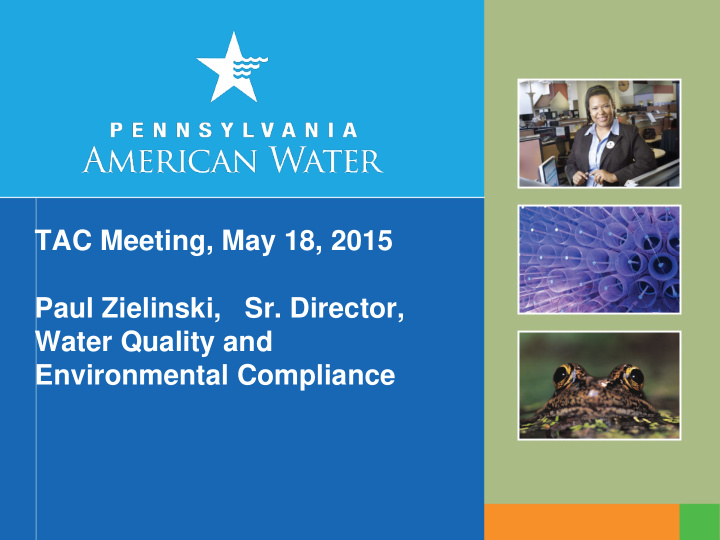



TAC Meeting, May 18, 2015 Paul Zielinski, Sr. Director, Water Quality and Environmental Compliance
Pennsylvania American Water Service Area Serving 17 percent of the Commonwealth’s population 2
Our Pennsylvania Infrastructure Source of Supply Storage & Transmission • 293 water storage tanks • 92% surface water • 268 booster pumping stations • 7% groundwater 1% purchased water • Distribution System • 10,242 miles of pipe • 53 regulated dams • 135 active groundwater well Water Capacity sources 196 MGD average daily • 36 surface water plants • delivery PWS – 66 total 3 3
Distribution System Complexity 1. Main Breaks 2. Hydrant Flushing 3. Biofilms 4. Cross Connections 5. Dead Ends 6. Large Tanks/Mains for Fire Service 7. Seasonal Customers 8. Food Sources for Organisms to Grow (Source Quality) 9. Varying Pipe Materials, Old Pipe 10.Developer Projects 11.Disinfection By-Products 12.Corrosion Control 13.Tank Vents, Replace Infrastructure 14.Pressure Management 4
Notifications Required under DEP Proposed Mandatory Disinfectant Levels Free Chlorine System (No Data for August, 2014) Month Number NOTE: All May, 2014 4 samples were June, 2014 3 void of total coliform July, 2014 7 bacteria. Sept., 2014 11 October, 2014 6 November, 2014 7 December, 2014 5 Jan, 2015 5 February, 2015 8 March, 2015 2 April, 2015 4 TOTAL 62 5
Notifications Required under DEP Proposed Mandatory Disinfectant Levels Chloraminated Systems – April, 2014 to April, 2015 (No Data for August, 2014) Month Number April, 2014 4 June, 2014 1 NOTE: All July, 2014 1 samples were void of total Sept., 2014 2 coliform bacteria. October, 2014 4 November, 2014 4 December, 2014 5 January, 2015 4 February, 2015 2 March, 2015 2 April, 2015 4 TOTAL 33 6
Suggestions 1. Use sound science to set mandatory disinfectant levels for a distribution system. Use national experts, identify research needs, and use PA stakeholder interaction. 2. Identify unwanted circumstances that may occur. 3. Use Capital Funds wisely, not unnecessarily. 7
Recommend
More recommend